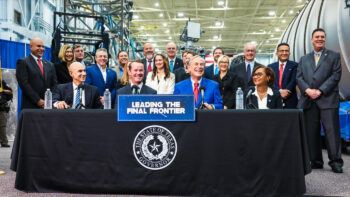Texas A&M Heeds Gov. Abbott’s Call For Space Engineering Degree

The incoming dean of the College of Engineering at Texas A&M University said Wednesday that he supports creating a degree program in Space Engineering.
Dr. Robert H. Bishop, whose official start date is Tuesday, said he has heard the call for the new program from several faculty members who want to make Texas A&M a national leader in the rapidly growing field of space engineering.
“I am thrilled to announce that one of my first orders of business is to help make Texas A&M a world leader in Space Engineering,” Bishop said. “Degrees in Space Engineering will give students at Texas A&M the skills they need to be pioneers in the space industry as they learn to establish exciting new systems for space exploration and research.”
Support for the new program comes from people beyond College Station. At an event with NASA officials and space industry leaders at Johnson Space Center on Tuesday, Gov. Greg Abbott urged Texas universities to consider establishing degree offerings in Space Engineering to help Americans get to the moon and Mars in the coming years.
At Tuesday’s event, Nancy Currie-Gregg, a former NASA astronaut with more than 1,000 hours in space who serves as director of the Texas A&M Space Institute, was named as an inaugural member of the Texas Space Commission’s nine-member board of directors, as were Texas A&M graduates John Shannon, Sarah “Sassie” Duggleby, Kirk Shireman and Evan Loomis.
In addition, Robert Ambrose, a professor of mechanical engineering at Texas A&M University who serves as deputy director of the Texas A&M Space Institute, was named to the Texas Aerospace Research and Space Economy Consortium (TARSEC) Executive Committee, along with Texas A&M graduate Stephanie Murphy and Matt Ondler, chairman of the Industry Advisory Board of the Texas A&M Multi-Disciplinary Engineering program.
Bishop said he appreciated the support of Abbott and state leaders — such as Lt. Gov. Dan Patrick, Speaker Dade Phelan, Rep. Greg Bonnen and Sen. Joan Huffman.
Widespread support for the program will help Texas A&M attract students from all over the U.S., Bishop said. Plus, it would give NASA and the growing number of private space companies a place to find the talent they need to build on the moon and Mars. Texas A&M’s College of Engineering already offers both baccalaureate and graduate degrees in aerospace engineering; the important distinction is that aerospace engineers get people to the moon and Mars, and space engineers build structures and operations there.
The College of Engineering at Texas A&M already has a strong foundation for new degrees in Space Engineering. The college has developed the Human Systems Integration and Bioastronautics graduate certificate program. It will be offered starting in fall 2024. It entails preparing professionals in engineering, human physiology and medicine to address the growing challenges of both civil and commercial human spaceflight. The program within the Department of Aerospace Engineering was developed based on demand from NASA and private space companies.
The College of Engineering at Texas A&M is one of the country’s top higher education institutions for space-related research and the ideal place for recruiting the highly skilled people to make sure the United States leads the race to the moon and Mars.
Texas A&M, which has been a space grant university since 1989, has four former astronauts on campus and has been conducting space-related research for years. The work of Texas A&M faculty and students includes: working now on newer and better space suits; developing robots for the lunar surface; researching micro-gravity manufacturing; exploring the effects of weightlessness on astronauts; figuring out how to build habitats for sustainable life in space, and more.
The vision for the Texas A&M Space Institute involves expanding Texas’s role as the leader in the new space economy. It would leverage Texas A&M’s existing expertise and resources to make new discoveries, technological developments, health advances and workforce growth.
In addition to the institute, Texas A&M is planning to build a $200 million facility, which was funded by the Texas Legislature last year, on land near the Johnson Space Center. It will include two massive areas designed to simulate the lunar landscape and the terrain of Mars, and they will be available to Texas A&M researchers, as well as private companies that are looking to test prototypes and new equipment designed to travel across the surfaces of the moon and Mars.
Development of the new academic program is a faculty-driven process targeted for implementation in fall 2025, with a series of internal and external reviews and approvals necessary prior to the program being launched, including approval by the Texas A&M University System Board of Regents and the state’s Higher Education Coordinating Board.
Media contact: Laylan Copelin, 979-458-6425, lcopelin@tamus.edu





